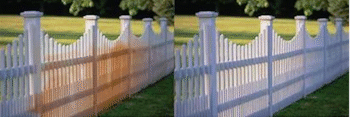
1
Water only when your grass needs it. Water conservation isn't the only reason to limit the amount of water you give your lawn. Overwatering is also bad for your lawn's health and can contribute to the development of fungus and disease. Some types of grass require more water than others, and environmental factors such as temperature, humidity, and wind can dramatically affect how frequently you need to water your lawn. Fortunately, the most accurate way to determine whether your lawn needs water is also the easiest: just look at the grass:
-
When grass needs water, it will begin to take on a blue-gray tint, and the older leaf blades on the plant will begin to curl up or wilt.
-
Footprints will remain on the grass for longer than usual, as the grass won't "bounce back." When 30 to 50% of your lawn shows these symptoms, it's time to water.
2
Water deeply to encourage deep root growth. Frequent shallow waterings encourage weed germination, and they also cause the grass plants' roots to grow shallow, leaving the plant more susceptible to drought and to certain diseases. Watering only when your grass really needs it encourages the roots to grow deeper, but only if you apply enough water each time to penetrate the root zone.
-
The most accurate way to determine the depth of the root zone is to dig a small hole and measure how far the roots go down.
-
Alternatively, you can follow these general approximations: if you have a bluegrass lawn, each watering should moisten the soil to 6 to 8 inches, while for most other grasses, the water should penetrate 8 to 12 inches. You can determine how long to leave the sprinkler system on by using one of the following methods:
-
Turn on your sprinkler for 15 minutes. After 18 to 24 hours, find out how deep the water soaked in by digging a small hole in the watered area or using a probe (a probe will push easily through damp ground). You can also push a shovel into the ground and use it as a lever to spread the soil apart enough so that you can see several inches below the surface. Once you see how deep the water went in 15 minutes, you can calculate how long you need to leave your sprinkler on.
-
For example, if the soil is damp to 4 inches below the surface and your goal is to moisten the soil to a depth of 8 inches, you'll need to leave the sprinkler on for 30 minutes (2 x 15 minutes) each time you water.
-
Estimate how much water you'll need based on your soil type. In general, 1 inch of water will penetrate sandy soils to 12 inches, loamy soils to 6 to eight inches, and clay soils 4 to 4 inches. Using these estimates isn't quite as accurate as digging, but it's pretty close, especially if you have a good knowledge of your soil composition. To figure out how long you need to keep your sprinkler or sprinkler system on, calibrate your sprinklers.
3
Water early in the morning. When you use sprinklers, some water evaporates before it hits the ground. On a hot, windy day, the amount of water that never reaches your grass can be substantial. To reduce loss to evaporation, water sometime between 4 A.M. and 9 A.M., when the air is still cool and the wind is usually at its calmest.
-
Avoid watering your lawn with hot water. On hot days, the water inside your hose can become very hot from solar energy—hot enough to scald! It's better to just skip watering that day, and water early the next morning. Run your hose after the sun has gone down, to empty out any hot water.
4
Aim your sprinklers to water the lawn. That's the part that needs the moisture—not the sidewalk or street! Slight adjustments to your sprinklers can save a lot of water. Ideally, you shouldn't water your sidewalk, patio, street, or driveway at all.
5
Avoid creating runoff. Even with sprinklers correctly targeted at the lawn, many people water until—or even after—water begins to run off the grass and into the street or driveway. This can waste a lot of water, and it isn't doing your lawn any good.
-
If water starts to run off your lawn before you've been able to give it a deep watering, turn off the water for 15 to 20 minutes to let the ground absorb the water, and then continue watering as needed (rotating a sprinkler between one area and another will also do the trick).
-
Some soil types absorb water more slowly than others, but runoff can also be caused by excessive thatch buildup, which can promote disease—which is sometimes caused by routine overwatering.
6
Let the rain do your work for you. Nothing looks more wasteful than running your sprinklers while it's raining. If your sprinkler system is on a timer, get and install a rain sensor that automatically turns the water off when it rains. If possible, also avoid watering if rain is expected later in the day or during the next day. Your grass should be fine, even if it looks stressed.
-
Use a rain gauge to determine how much rain you received, and then water a bit more only if needed.
-
If you're expecting rain, and your soil is dry, run the sprinkler to moisten it so that the soil absorbs the rain more easily.
7
Get a Rain Barrel. Use a rain barrel to water gardens and landscapes. A properly installed rain barrel harvests rain water from the gutters of your home and provides ample water for gardens and landscape areas. Capturing this rain water reduces the amount of run off that may otherwise be picking up garbage, oils, fertilizers, pesticides and other pollutants that are on your lawn, sidewalk and street. This also reduces the amount of pollution getting into our rivers, lakes, streams and ocean.
8
Water problem areas by hand. Many lawns have one or two spots that require more water than the rest of the lawn. A south-facing slope (or, in the Southern Hemisphere, a north-facing slope), or an unshaded area in an otherwise shady lawn are two common examples of these "problem areas." If you water your entire lawn every time you need to water these hot spots, you'll likely overwater everyplace but these spots. Instead, water them by hand or use a separate sprinkler that's not attached to the rest of your irrigation system.
 Help is finally here! By treating the high minerals and iron content we can eliminate the unsightly occurrence and give you the beautiful lawn and property that you intended to have when you installed the irrigation system in the first place. We will first test the water to understand the extend of your issue. Then we’ll eliminate the chemicals by installing mechanisms in your system to counter the high iron content. We highly recommend this service, as you’ll be able to see great results, and a much nicer looking outdoor living area (without rust stains) if your primary water source is well water.
Help is finally here! By treating the high minerals and iron content we can eliminate the unsightly occurrence and give you the beautiful lawn and property that you intended to have when you installed the irrigation system in the first place. We will first test the water to understand the extend of your issue. Then we’ll eliminate the chemicals by installing mechanisms in your system to counter the high iron content. We highly recommend this service, as you’ll be able to see great results, and a much nicer looking outdoor living area (without rust stains) if your primary water source is well water.
